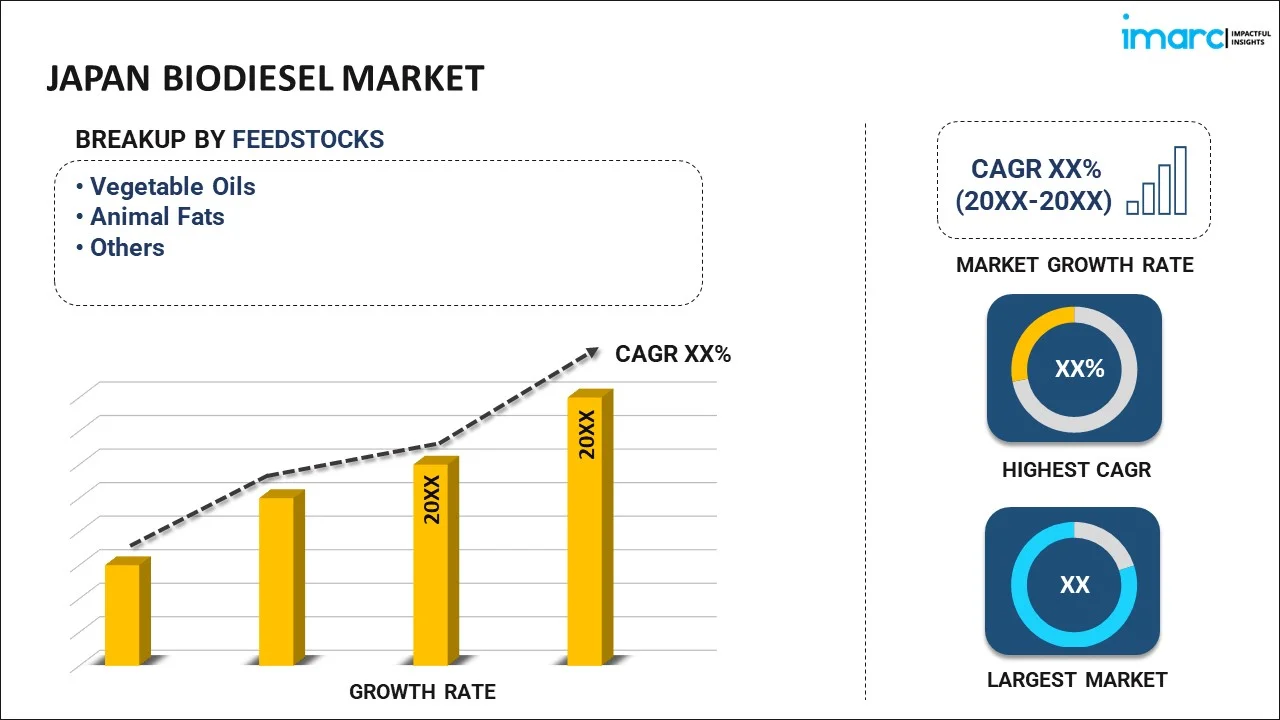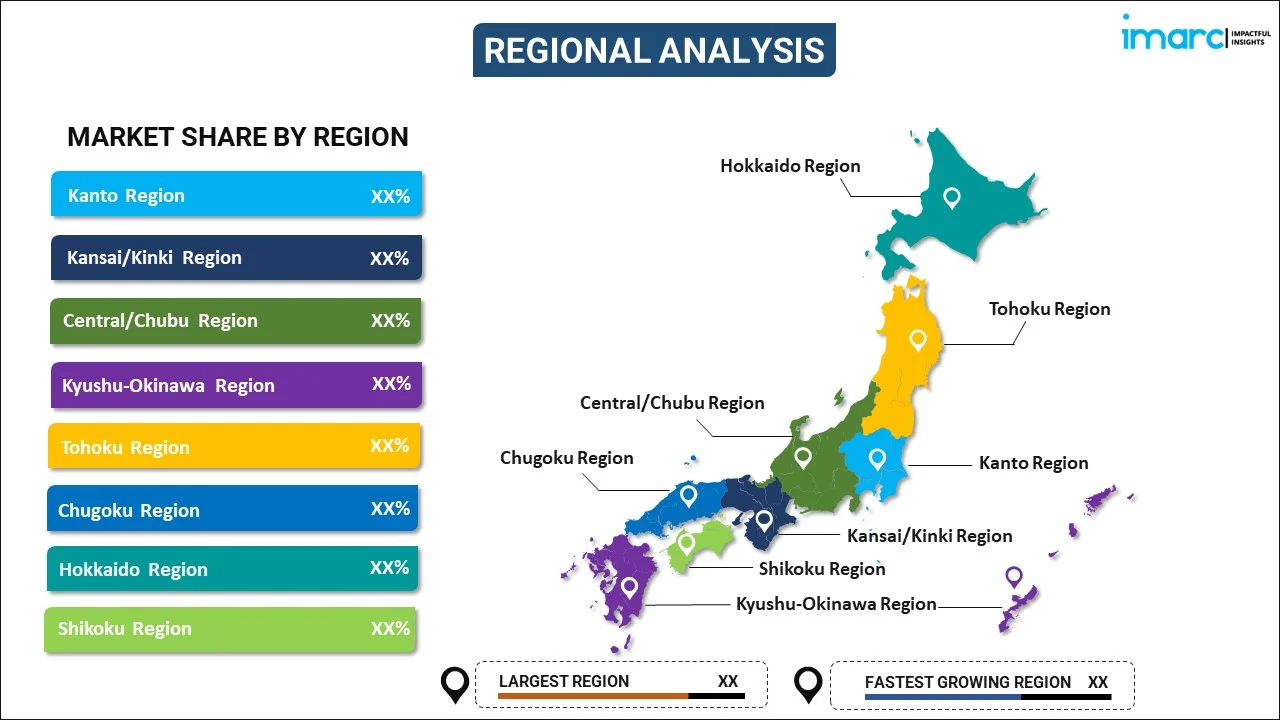
Japan Biodiesel Market Report by Feedstock (Vegetable Oils, Animal Fats, and Others), Application (Fuel, Power Generation, and Others), Type (B100, B20, B10, B5), Production Technology (Conventional Alcohol Trans-esterification, Pyrolysis, Hydro Heating), and Region 2025-2033
Market Overview:
Japan biodiesel market size reached USD 2,726.4 Million in 2024. Looking forward, IMARC Group expects the market to reach USD 7,917.8 Million by 2033, exhibiting a growth rate (CAGR) of 12.6% during 2025-2033. The increasing advances in biodiesel production technologies, such as improved feedstock selection, processing methods, and catalysts, that can enhance efficiency and reduce costs, are driving the market.
|
Report Attribute
|
Key Statistics
|
|---|---|
|
Base Year
|
2024
|
|
Forecast Years
|
2025-2033
|
|
Historical Years
|
2019-2024
|
|
Market Size in 2024
|
USD 2,726.4 Million |
|
Market Forecast in 2033
|
USD 7,917.8 Million |
| Market Growth Rate 2025-2033 | 12.6% |
Biodiesel is a renewable and environmentally friendly alternative to traditional diesel fuel, derived from organic sources such as vegetable oils, animal fats, or recycled cooking oils. The production process, known as transesterification, involves reacting these feedstocks with alcohol to create biodiesel and glycerin as a byproduct. Biodiesel can be used in diesel engines without modifications, offering a cleaner-burning fuel that reduces greenhouse gas emissions, sulfur, and particulate matter. Its use contributes to lower levels of air pollutants and mitigates dependence on fossil fuels. Additionally, biodiesel can be produced domestically, promoting energy security and rural development. Its versatility allows it to blend with conventional diesel or be used as a pure fuel, making it a sustainable and viable option for transportation, agriculture, and various industrial applications.
Japan Biodiesel Market Trends:
The biodiesel market in Japan is experiencing robust growth, primarily driven by the escalating demand for sustainable energy sources amid increasing environmental concerns. Furthermore, the push towards reducing carbon emissions and mitigating climate change has become a pivotal factor propelling the biodiesel industry forward. Governments in Japan are implementing stringent regulations favoring cleaner alternatives, creating a conducive environment for biodiesel market expansion. Additionally, the rising awareness among consumers about the environmental impact of traditional fossil fuels has led to a surge in demand for biodiesel as a greener alternative. Moreover, the volatile nature of conventional fuel prices has prompted a shift towards biodiesel, as it offers a more stable and predictable energy source. The agricultural sector's involvement in biodiesel production, particularly from feedstocks like soybean and rapeseed, plays a significant role in market dynamics. This connection between agriculture and biodiesel production not only ensures a renewable source of energy but also contributes to rural economic development. As technological advancements continue to enhance the efficiency of biodiesel production processes, the regional market is poised for sustained growth, driven by an intricate interplay of environmental consciousness, regulatory support, and economic considerations.
Japan Biodiesel Market Segmentation:
IMARC Group provides an analysis of the key trends in each segment of the market, along with forecasts at the country level for 2025-2033. Our report has categorized the market based on feedstock, application, type, and production technology.
Feedstock Insights:

- Vegetable Oils
- Animal Fats
- Others
The report has provided a detailed breakup and analysis of the market based on the feedstock. This includes vegetable oils, animal fats, and others.
Application Insights:
- Fuel
- Power Generation
- Others
A detailed breakup and analysis of the market based on the application have also been provided in the report. This includes fuel, power generation, and others.
Type Insights:
- B100
- B20
- B10
- B5
The report has provided a detailed breakup and analysis of the market based on the type. This includes B100, B20, B10, and B5.
Production Technology Insights:
- Conventional Alcohol Trans-esterification
- Pyrolysis
- Hydro Heating
A detailed breakup and analysis of the market based on the production technology have also been provided in the report. This includes conventional alcohol trans-esterification, pyrolysis, and hydro heating.
Regional Insights:

- Kanto Region
- Kansai/Kinki Region
- Central/ Chubu Region
- Kyushu-Okinawa Region
- Tohoku Region
- Chugoku Region
- Hokkaido Region
- Shikoku Region
The report has also provided a comprehensive analysis of all the major regional markets, which include Kanto Region, Kansai/Kinki Region, Central/ Chubu Region, Kyushu-Okinawa Region, Tohoku Region, Chugoku Region, Hokkaido Region, and Shikoku Region.
Competitive Landscape:
The market research report has also provided a comprehensive analysis of the competitive landscape. Competitive analysis such as market structure, key player positioning, top winning strategies, competitive dashboard, and company evaluation quadrant has been covered in the report. Also, detailed profiles of all major companies have been provided.
Japan Biodiesel Market Report Coverage:
| Report Features | Details |
|---|---|
| Base Year of the Analysis | 2024 |
| Historical Period | 2019-2024 |
| Forecast Period | 2025-2033 |
| Units | Million USD |
| Scope of the Report | Exploration of Historical and Forecast Trends, Industry Catalysts and Challenges, Segment-Wise Historical and Predictive Market Assessment:
|
| Feedstocks Covered | Vegetable Oils, Animal Fats, Others |
| Applications Covered | Fuel, Power Generation, Others |
| Types Covered | B100, B20, B10, B5 |
| Production Technologies Covered | Conventional Alcohol Trans-esterification, Pyrolysis, Hydro Heating |
| Regions Covered | Kanto Region, Kansai/Kinki Region, Central/ Chubu Region, Kyushu-Okinawa Region, Tohoku Region, Chugoku Region, Hokkaido Region, Shikoku Region |
| Customization Scope | 10% Free Customization |
| Post-Sale Analyst Support | 10-12 Weeks |
| Delivery Format | PDF and Excel through Email (We can also provide the editable version of the report in PPT/Word format on special request) |
Key Questions Answered in This Report:
- How has the Japan biodiesel market performed so far and how will it perform in the coming years?
- What has been the impact of COVID-19 on the Japan biodiesel market?
- What is the breakup of the Japan biodiesel market on the basis of feedstock?
- What is the breakup of the Japan biodiesel market on the basis of application?
- What is the breakup of the Japan biodiesel market on the basis of type?
- What is the breakup of the Japan biodiesel market on the basis of production technology?
- What are the various stages in the value chain of the Japan biodiesel market?
- What are the key driving factors and challenges in the Japan biodiesel?
- What is the structure of the Japan biodiesel market and who are the key players?
- What is the degree of competition in the Japan biodiesel market?
Key Benefits for Stakeholders:
- IMARC’s industry report offers a comprehensive quantitative analysis of various market segments, historical and current market trends, market forecasts, and dynamics of the Japan biodiesel market from 2019-2033.
- The research report provides the latest information on the market drivers, challenges, and opportunities in the Japan biodiesel market.
- Porter's five forces analysis assist stakeholders in assessing the impact of new entrants, competitive rivalry, supplier power, buyer power, and the threat of substitution. It helps stakeholders to analyze the level of competition within the Japan biodiesel industry and its attractiveness.
- Competitive landscape allows stakeholders to understand their competitive environment and provides an insight into the current positions of key players in the market.
Need more help?
- Speak to our experienced analysts for insights on the current market scenarios.
- Include additional segments and countries to customize the report as per your requirement.
- Gain an unparalleled competitive advantage in your domain by understanding how to utilize the report and positively impacting your operations and revenue.
- For further assistance, please connect with our analysts.
 Inquire Before Buying
Inquire Before Buying
 Speak to an Analyst
Speak to an Analyst
 Request Brochure
Request Brochure
 Request Customization
Request Customization




.webp)




.webp)












